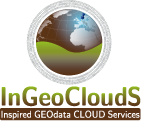![]()
One-Geology Europe

Geo-Seas

EuroGeoSource
![]()
PanGeo
![]()
EMODNET-Geology

INspired GEOdata CLOUD Services
__________________________________________________
One-Geology Europe
This project succeeded in developing a harmonised datamodel (based on existing international standards) for 1:1 million geological map data, and serving these data for 21 countries through OGC-compliant web services in a multilingual portal in 18 languages. The project also succeeded in developing a single license for use of these data. However, even in this project a large number of European countries did NOT participate, including Austria, Greece, Iceland, Switzerland, and most of the Balkan countries. Also, although OneGeology- Europe provided a very good start for exploring harmonisation of shared data, the usefulness of 1:1million map data is limited for many applications. Because of the success and attention received by OneGeology-Europe, the EuroGeoSurveys Board of Directors has recently decided to extend the coverage of OneGeology-Europe by adding additional countries’ maps to the portal (9 countries have agreed to do this), as well as increase the resolution to at least 1:250.000 (if data are available). This effort will be carried out on the basis if EuroGeoSurveys members’ own resources. However, since NGSO all have a national rather than a European mandate, resources for such activities are limited, and insufficient to allow, for example, additional efforts to further elaborate the data model to make higher resolution data truly harmonised.
__________________________________________________
Geo-Seas
Geo-Seas is implementing an e-infrastructure for the delivery and exchange of marine geological and geophysical data from more than 20 data centres. Users are able to identify, locate and access pan-European, harmonised and federated marine geological and geophysical datasets and derived data products held by the data centres through a dedicated Geo-Seas portal. As with OneGeology-Europe, the aims of the Geo-Seas project are aligned with European directives and recent large-scale framework programmes on global and European scales, such as GEOSS and GMES, EMODNet and INSPIRE. In this respect, Geo-Seas is in many ways complementary to the EGDI proposed here, which will in first instance focus on continental data. There is a real challenge though in developing the connection between continental and marine geology, which in many countries are separated domains. Developing the EGDI can contribute to this effort.
__________________________________________________
EuroGeoSource
EuroGeoSource is a project focussing on harmonization of geo-energy and mineral resource data based on key economic and geological parameters, currently including 11 partners
__________________________________________________
PanGeo
PanGeo is a project developing a “ground stability layer” delineating areas of (potential) ground instability in urban regions, involving all 27 member states but covering only 2 cities in each of them. PanGeo results will be served through the current OneGeology-Europe portal.
__________________________________________________
EMODNET-Geology
EMODNET-Geology brings together harmonised off-shore data including sea-floor geology (age, lithology, origin), boundaries and faults, rate of coastal erosion or sedimentation, geological events and event probabilities (landslides, volcanic, earthquake epicentres), seismic profiles, and minerals (including aggregates, oil and gas)). The next phase of the EMODNET project is to deliver these maps at a higher resolution and also to extend the project consortium from its current focus on northern Europe to include more partners, especially those in southern Europe. EMODNET data are currently already being delivered through the OneGeology-Europe portal.
__________________________________________________
INspired GEOdata CLOUD Services
The INspired GEOdata CLOUD Services (InGeoCLOUDS) project aims at demonstrating the feasibility of employing a cloud-based infrastructure coupled with the necessary services to provide seamless access to geospatial public sector information, especially targeting the geological, geophysical and other geoscientific information. This kind of information possesses interesting characteristics like the size of the available data, the existing metadata descriptions (mostly according to the European Directive INSPIRE) and the current availability of related services that can be moved to the cloud.
More projects will be added.
